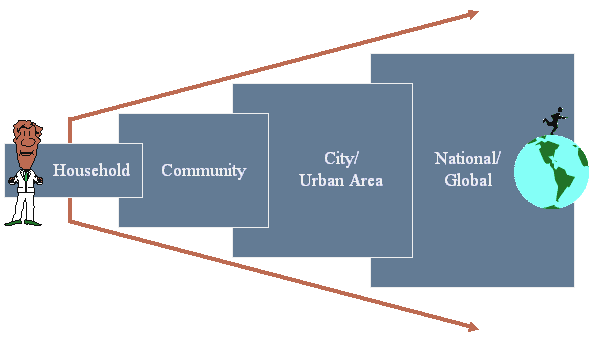The framework is presented as a series of statements. Each statement is briefly explained and is supported by resources available on the UEM Homepage.
URBAN ENVIRONMENTS
Urban Environments pose a challenge for effective distribution and management of global resources
As illustrated in the Numbers section, the density and population of today's cities necessitates the equitable distribution of resources that are needed for its various activities. It is therefore necessary to understand the effects of an urban area not only within its immediate boundaries, but also on the region and country it is positioned, due to the large amount of resources necessary to sustain it.
BALANCING ACTS
There is a need to strike a balance between natural and built environments and between ecological and economic objectives.
Agglomeration and centrality of resources and skills that an urban area offers should not be ignored, but should be balanced with the natural environment, including air, water, land, and mineral resources. Economic objectives in job creation, income generation and distribution,particularly for developing countries, will have to be tempered with ecological objectives of sustainable living. The priority that developing cities place on economic development and income distribution over that of environmental issues has to be understood from the larger perspective of long-term human development.
VISIONING
There is a need to develop a structure of goals/visions and a methodology to achieve it in order to identify the action that has to be taken
A structure of goals and visions for sustainable urban living, that can easily be understood by ordinary citizens should be developed. This will allow communities and governments to discuss ways in which this can be achieved. It also attributes legitimacy and currency for the problems faced in urban environmental management, and sets the platform on which these problems can be addressed. The scale of UEM problems should be understood, so that appropriate action can be taken at the appropriate level.
ACTION PLANS
Steps need to be taken that are relevant in the short term in order to gain wider acceptability, keeping long term goals in mind
In relation to the previous point, the goals and visions have to be divided into immediate, intermediate and eventual goals, so that the issues are better understood, and tangible/visible results can be achieved. Sharing and cooperating on essential lessons, practices and technologies is critical to achieving such goals.
INFORMATION MANAGEMENT
Access, sharing and dissemination of information has to be a priority to achieve greater understanding of the issues involved
The cause-and-effect reasoning of local actions has to be understood from a regional and global perspective. For example, what is the effect of drinking a cup of coffee on coffee growers in South America? Key to achieving this understanding and exploration is information, and its easy, adequate and immediate access. Timely and packaged Information is key to influence local decision-making processes, which on a cumulative basis, have global repercussions.
KNOWLEDGE TRANSFER
Collaborative efforts in 'knowledge transfer' at the city-to-city level has to be encouraged, particularly between developed and developing cities
Collaboration with institutions and governments in developed and developing countries for the transfer of urban 'software' (Inspiring ideas and best practices, innovative technologies, practical solutions, etc.) has to be encouraged - covering among other issues, policies, programmes, skills, local and city governance. Feasibility and transferability of such software will have to be studied in depth before
collaborative projects are launched.
SUSTAINABILITY
There is a need to understand and enact the concept of sustainable development and sustainable living, in all its varied definitions
Wider participation to achieve the goals of sustainable development and living has to be encouraged. This has to involve the community, local governments, and the whole range of non-governmental organizations (including the private sector). Sustainable living should become a way of life, rather than a fancy concept that is espoused by a 'enlightened' few.
TECHNOLOGY
Development of new technologies that are clean, green, and practical has to be encouraged and exchanged between local and city governments to combat environmental problems
Consequences of current polluting technologies has to be weighed in terms of their effect on the environment, while transfer of environmental technologies has to be enabled through a variety of governmental and non-governmental forums, including those online.

